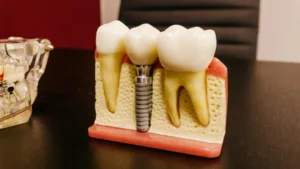Restoring rotten teeth can transform your smile and boost your confidence.
- Recognize the root causes: Understand how decay progresses and the importance of early detection.
- Explore treatment options: Learn about the various methods to restore teeth, from fillings to implants.
- Prevent future decay: Discover tips to maintain oral health and keep your teeth strong.
Begin your journey to a healthier smile by learning about rotten teeth restoration.
Understanding Tooth Decay
Tooth decay, also known as dental caries or cavities, is a common issue that can significantly affect your oral health. When you consume foods and drinks high in sugar and starches, the bacteria in your mouth produce acids that can erode tooth enamel. Over time, this erosion creates tiny holes or cavities.
The Science Behind Tooth Decay
The process of tooth decay involves several stages. Initially, plaque, a sticky film of bacteria, forms on your teeth. When you eat or drink sugary substances, these bacteria produce acids. Over time, the acids dissolve mineral content from your enamel, leading to the formation of cavities.
Factors Contributing to Tooth Decay
Several factors can accelerate the decay process:
- Diet: Frequent consumption of sugary or starchy foods.
- Poor Oral Hygiene: Inadequate brushing and flossing.
- Lack of Fluoride: Fluoride helps remineralize and strengthen enamel.
- Dry Mouth: Saliva helps wash away food particles and neutralize acids.
- Age: Both children and older adults are at higher risk.
At My New Tooth, we emphasize the importance of preventive care and early intervention to combat tooth decay effectively.
Advanced Stages of Tooth Decay
If left untreated, decay progresses deeper into the tooth:
- Enamel Curvature: Initial decay that affects only the outer enamel.
- Dentin Decay: The bacteria invade the softer dentin layer beneath the enamel.
- Pulp Infection: The innermost pulp becomes infected, causing pain and potentially leading to tooth abscesses.
- Tooth Loss: Severe decay can result in tooth extraction or loss.
Understanding these stages helps you recognize the importance of timely dental treatment.
Symptoms of Rotten Teeth
Rotten teeth can cause various symptoms, which can impact your daily life. Recognizing these symptoms early can lead you to seek treatment before the problem worsens.
Common Signs of Rotten Teeth
Here are some symptoms you might notice:
- Toothache: Persistent pain that can occur without any apparent cause.
- Sensitivity: Discomfort when consuming hot, cold, sweet, or acidic foods and beverages.
- Discoloration: Dark spots, bad breath, and unpleasant taste on the tooth’s surface.
- Bad Breath: Persistent foul odor due to decay and bacterial growth.
- Visible Cavities: Holes or pits in your teeth.
- Swelling: Inflammation in gums or around the tooth, indicating possible infection.
Impacts on Daily Life
- Pain and Discomfort: Chronic pain can disrupt daily activities and sleep.
- Aesthetic Concerns: Discolored or damaged teeth can affect your confidence.
- Oral Health: Advanced decay can lead to infections, impacting overall health.
Identifying these symptoms can prompt you to seek restorative treatments promptly.
Diagnosis and Assessment
Diagnosing the extent of tooth decay is the first step towards effective treatment. Dentists use various techniques to assess the severity of the decay.
Visual Examination
During a routine dental check-up, your dentist will visually inspect your teeth for signs of decay. They will look for discolorations, visible cavities, and any abnormalities in your teeth and gums.
Diagnostic Tools and Tests
Dentists use several tools to diagnose both surface-level and deeper dental issues:
- Dental Explorer: A metal probe used to feel for soft spots indicating decay.
- X-rays: Radiographs help reveal the extent of decay and any underlying issues not visible to the naked eye.
- Laser Devices: Some practices use laser fluorescence devices to detect decay early.
- Cavity Detection Dye: A special dye applied to teeth can highlight areas affected by decay.
Comprehensive Dental Check-ups
Regular dental check-ups involve a combination of the above diagnostic methods. Your dentist will create a detailed treatment plan based on the findings, ensuring the best possible outcomes for your oral health.
Treatment Options for Mild Decay
Treating tooth decay early can prevent further deterioration and restore your tooth’s function and appearance. Mild decay typically involves less invasive treatments.
Dental Fillings
A common restorative option for cavities is fillings. Dentists remove the decayed portion of the tooth and fill the cavity with materials like amalgam, composite resin, or gold.
- Composite Fillings: Resin-based and tooth-colored, ideal for aesthetic purposes.
- Amalgam Fillings: Durable and suitable for back teeth due to their strength.
- Gold Fillings: Long-lasting but more expensive.
Dental Bonding
Dental bonding involves applying a tooth-colored resin to the decayed area, which is then shaped and polished to match your tooth. This technique is useful for small cavities and minor aesthetic improvements.
Benefits of Early Treatment
- Preserve Tooth Structure: Treating cavities early prevents extensive decay.
- Prevent Pain: Early intervention alleviates discomfort and pain.
- Restore Function: Restorations enable you to chew comfortably and maintain oral functions.
Regular dental visits and prompt treatment can save you from more extensive procedures down the line.
Crowns and Bridges for Advanced Decay
When decay reaches an advanced stage, simple fillings may not suffice. Crowns and bridges can provide durable and aesthetically pleasing solutions.
Dental Crowns
Crowns, also known as caps, cover the entire tooth, restoring its shape, size, and strength. Your dentist will remove the decayed portion and reduce the tooth structure to fit the crown. Materials used for crowns include:
- Porcelain: Natural-looking and often used for front teeth.
- Ceramic: Similar to porcelain but more durable.
- Metal Alloys: Durable and ideal for back teeth, although not as aesthetically pleasing.
- Porcelain-Fused-to-Metal (PFM): Combines strength and aesthetics.
Indications for Crowns
- Severe Decay: Extensive decay that weakens the tooth structure.
- Cracked or Broken Teeth: Repair and protect damaged teeth.
- Post-Root Canal: Restore teeth after root canal therapy.
Dental Bridges
Bridges fill gaps caused by missing teeth. They consist of crowns on either side of the gap, with a false tooth (pontic) in between. Types of bridges include:
- Traditional Bridges: Most common, with crowns on adjacent teeth.
- Cantilever Bridges: Anchored on only one side, used when only one adjacent tooth is available.
- Maryland Bridges: Bonded to the back of adjacent teeth with metal or porcelain wings.
Advantages of Bridges
- Restore Function: Enable proper chewing and speech.
- Aesthetic Improvement: Fill gaps for a natural smile.
- Prevent Shifting: Stop adjacent teeth from moving into the vacant space.
Crowns and bridges provide reliable solutions for restoring severely decayed or missing teeth, enhancing both function and appearance.
Dentures and Partial Dentures
When multiple teeth are decayed or missing, dentures can offer a comprehensive replacement solution. Dentures come in two main types: full dentures and partial dentures.
Full Dentures
Full dentures replace all the teeth in your upper or lower arch. They consist of a gum-colored acrylic base with artificial teeth attached. Full dentures:
- Improve Aesthetics: Provide a natural-looking set of teeth.
- Restore Function: Allow you to chew and speak properly.
- Support Facial Structure: Maintain the shape of your face by supporting your cheeks and lips.
Partial Dentures
Partial dentures fill in gaps left by missing teeth, anchored to your remaining natural teeth. They typically have a metal framework with clasps that attach to your natural teeth. Benefits include:
- Retention of Natural Teeth: Preserve your remaining teeth while filling in gaps.
- Custom Fit: Made to fit your specific dental structure for comfort and utility.
- Improved Oral Health: Prevents the complications associated with missing teeth, such as shifting and bone loss.
Considerations When Choosing Dentures
- Fit and Comfort: Proper fitting is crucial for comfort and functionality. Your dentist will take precise measurements and make adjustments to ensure a perfect fit.
- Maintenance: Dentures require daily cleaning to maintain oral hygiene and prevent infections.
- Regular Check-ups: Periodic dental visits are essential for adjusting fit and monitoring oral health.
Dentures, whether full or partial, can significantly improve your quality of life by restoring your ability to eat, speak, and smile confidently.
Dental Implants as a Permanent Solution
Dental implants offer a long-lasting and reliable solution for restoring rotten teeth. At My New Tooth, we recommend implants for their remarkable durability and natural appearance. They can restore both functionality and aesthetics, ensuring a confident smile.
What are Dental Implants?
Dental implants are titanium posts surgically placed into the jawbone. They act as artificial tooth roots, providing a stable foundation for replacement teeth.
Benefits of Dental Implants
Dental implants offer numerous advantages compared to other tooth restoration methods:
- Durability: Implants can last a lifetime with proper care.
- Natural Appearance: Implants look and feel like natural teeth.
- Functionality: They restore full chewing and speaking abilities.
- Bone Health: Implants stimulate jawbone growth, preventing bone loss.
- Aesthetic Improvement: They maintain your facial structure and appearance.
The Implant Process
- Consultation: A detailed examination to assess your suitability for implants.
- Placement: Surgically inserting the titanium post into the jawbone.
- Osseointegration: The bone fuses with the implant, securing it in place.
- Abutment Placement: Attaching a connector to the implant post.
- Crown Placement: A custom crown is placed on the abutment to complete the restoration.
Each stage may require healing time, but the result is a permanent, natural-looking tooth.
Considerations and Aftercare
While dental implants have a high success rate, proper oral hygiene is crucial. Routine dental visits and good home care practices will ensure the longevity of your implants.
Veneers for Aesthetic Restoration
If your teeth have minor decay or discoloration, veneers might be the perfect solution. Veneers are thin, custom-made shells designed to cover the front surface of your teeth, improving their appearance.
How Veneers Work
Veneers are typically made of porcelain or composite resin. Your dentist bonds them to the front of your teeth after removing a small amount of enamel to ensure a perfect fit.
Benefits of Veneers
- Aesthetic Appeal: They can dramatically improve the appearance of your smile.
- Stain Resistance: Porcelain veneers resist stains better than natural teeth.
- Customizability: Veneers are tailored to match the color, shape, and size of your natural teeth.
Application Process
- Consultation: Discuss your aesthetic goals with your dentist.
- Preparation: A small amount of enamel is removed from your teeth.
- Impressions: Detailed molds of your teeth are taken.
- Bonding: Once the veneers are ready, they are bonded to your teeth with strong dental cement.
Veneers can transform your smile with minimal invasion and discomfort.
Preventing Further Tooth Decay
Prevention is key to maintaining healthy teeth and avoiding future restoration procedures. By adopting good oral hygiene practices and making informed dietary choices, you can protect your teeth from decay.
Oral Hygiene Practices
- Brushing: Brush your teeth at least twice a day with a fluoride toothpaste.
- Flossing: Floss daily to remove plaque and food particles between your teeth.
- Mouthwash: Use an antimicrobial mouthwash to reduce bacteria and freshen your breath.
Dietary Choices
- Limit Sugary and Starchy Foods: These can contribute to plaque formation and decay.
- Drink Water: Water helps wash away food particles and reduces acid levels in your mouth.
- Consume Dairy Products: Foods rich in calcium strengthen your tooth enamel.
Regular Dental Check-ups
Visit your dentist regularly for professional cleanings and check-ups. Regular visits help catch any early signs of decay and ensure your teeth remain healthy.
The Role of Professional Whitening Treatments
Professional whitening treatments can dramatically improve the appearance of your teeth, especially after restoring decayed teeth. Unlike over-the-counter products, professional treatments provide noticeable and long-lasting results.
Advantages of Professional Whitening
- Effective Results: Achieve a brighter smile quickly and safely.
- Customized Treatments: Whitening treatments are tailored to your specific needs.
- Safety: Professional supervision ensures the safety of your teeth and gums.
Whitening Process
- Consultation: Discuss your whitening goals with your dentist.
- Preparation: Your dentist will clean your teeth to ensure even whitening.
- Application: A safe, high-concentration whitening gel is applied.
- Activation: Special light or laser may activate the gel for faster results.
Professional whitening can give you a dazzling smile, enhancing the results of your tooth restoration efforts.
Consulting with a Dental Professional
Consulting with a dental professional is crucial for personalized treatment and optimal outcomes. A dentist will assess your specific situation, diagnose the extent of decay, and recommend the most suitable restoration options.
Importance of Professional Guidance
- Accurate Diagnosis: Dentists use advanced tools to evaluate your oral health.
- Tailored Treatment Plans: Customized solutions based on your unique needs.
- Expert Care: Professional treatment ensures quality and longevity of restorations.
What to Expect in a Consultation
- Assessment: Comprehensive oral examination and x-rays.
- Discussion: Review of your dental history and current concerns.
- Plan: Development of a detailed treatment plan tailored to you.
By working closely with a dental professional, you’ll achieve the best possible results in your tooth restoration journey.
Conclusion: Taking the First Step Towards a Healthier Smile
Restoring rotten teeth is possible with modern dental treatments. By understanding the causes and symptoms of decay, exploring the available treatment options, and taking preventive measures, you can reclaim your healthy smile.
Take the first step today. Schedule a consultation at My New Tooth and embark on your tooth restoration journey. Your healthier, brighter smile awaits.




